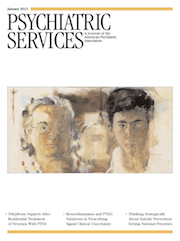Benzodiazepine Prescribing Variation and Clinical Uncertainty in Treating Posttraumatic Stress Disorder
Abstract
Objective
Despite guideline recommendations against their use, benzodiazepines are among the most commonly prescribed psychotropic medications among veterans with posttraumatic stress disorder (PTSD) in the Veterans Health Administration (VHA). This observation suggests the potential for significant clinical uncertainty concerning the role of benzodiazepines in PTSD, which was examined by characterizing prescribing variation in the VHA across multiple levels of geographic aggregation and over time.
Methods
Veterans with PTSD were identified from national VHA administrative data in fiscal years 1999 through 2009. Benzodiazepine prescribing frequencies were aggregated across 137 medical centers, 21 networks, and four U.S. regions, and the extent of variation was characterized at each level. Prescribing variation was also examined by comparing benzodiazepine use between rural and urban veterans and between veterans receiving care at community-based outpatient clinics versus medical centers.
Results
Benzodiazepine prescribing variation decreased over time, particularly at the network and regional levels. Facility-level variation (medical centers) also declined, but substantial variation persisted through 2009 (range 14.7%–56.8%). At the national level, rural veterans were more likely to receive benzodiazepines in 1999 (odds ratio=1.24; 95% confidence interval=1.22–1.27), and this association persisted through 2009. However, regional subanalyses revealed that rural-versus-urban differences were observed only in the Midwest and South. Benzodiazepine prescribing was similar between community-based outpatient clinics and medical centers.
Conclusions
Variability in benzodiazepine prescribing across the VHA reflects uncertainty regarding the adoption of guideline recommendations. Although variation has decreased in recent years, targeted interventions among facilities with high rates of prescribing may be an efficient strategy to promote guideline-concordant care.



